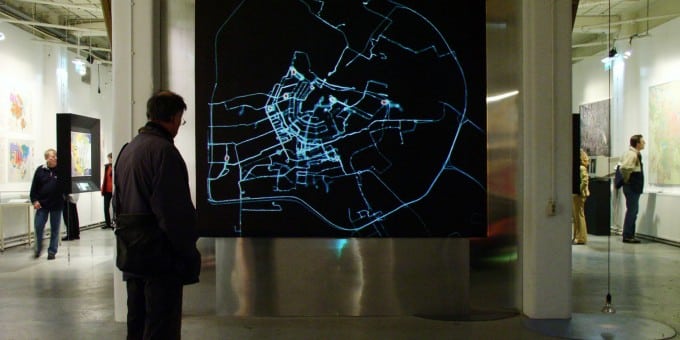 In our everyday life, we usually follow fixed paths and trajectories throughout the day: from our home to work or school, to family, to familiar stores and to places where we spend our free time. We all have invisible maps in our head: of our immediate surroundings and of the roads we take every day. The way we move around in the city, and the choices we make in this process, are determined by this mental map.
In our everyday life, we usually follow fixed paths and trajectories throughout the day: from our home to work or school, to family, to familiar stores and to places where we spend our free time. We all have invisible maps in our head: of our immediate surroundings and of the roads we take every day. The way we move around in the city, and the choices we make in this process, are determined by this mental map.
In collaboration with Waag Society, Jeroen Kee and the Amsterdam Archive
For the exhibition ‘Maps of Amsterdam 1866-2000’, Waag Society and Esther Polak together with Jeroen Kee were invited by the Amsterdam City Archive to produce a work about mental maps in that city: ‘Amsterdam RealTime’. During two months, 75 volunteers were tracked by GPS in their everyday movements and routines around the city. These traces were then drawn as white lines over a black background. The resulting, animated map has a distinct look and feel of psychogeographic experience: it is not precise or rational, but expresses the intuitive and personal aspects of geography. It shows a city that does not consist of buildings, roads and water, but of the movement of its inhabitants. Thicker and brighter lines indicate greater frequency of travel. The map also was influenced by the variety of means of transportation: a cyclist will produce completely different traces than someone who drives a car. Once the participants became aware of their mapping outcomes, some even attempted to create artful GPS drawings. Interestingly, the final, combined map of all individual traces resembles an objective city map again.
‘Amsterdam RealTime’ is a pioneering and seminal project that demonstrates intuitive, spatial relationships between urban residents and their city. It allowed the tracked participants to become more aware of their whereabouts and reveals a new form of shared experience. Viewers of the map get involved in a mixture of aesthetic experience, identification and participation – but also a bit of voyeurism. In the installation and on the Amsterdam RealTime website, visitors can choose to browse and explore individual participants’ maps or to see the combined map as a whole.
Artistic motivation
The starting point for this work was our curiosity to find out if it was possible to make a map of Amsterdam emerge from authentic route data. We wanted the city to draw itself. Also we wanted the audience that witnessed the realtime emergence of the tracks to identify with the participants rather than taking a voyeuristic position.
Practical information
AmsterdamREALTIME 2002; Esther Polak, Jeroen Kee and Waag Society. The project is available for exhibition purposes in the form of a looping, projected flash animation (20 min.) and (optional) a series of prints.
Distribution via LIMA Amsterdam
Archiving video showing the original flash-website:
press/writing
find a complete press and writings archive here
2002
Trouw 12 okt. 2002 Grootse Amsterdamse visioenen Hans Masselink
NRC Handelsblad, 2002 23 nov Hollands Dagboek: David Elders
2003
NRC Handelsblad, 2003 feb 21: Cornel Bierens ‘waar zijn die vogels dan?’
Wired, 2003 nr3 : ‘Emerging Traffic’
Bizz magazine, Zzap! 2003, aprilnummer: ‘GPS-systeem wekt stadskaart tot leven’
Verkeerskunde, bedrijfsleven, nr. 4: 2003: ‘GPS in Art’
Computable, 16.05.03: foto voorpagina
2006
ACME-journal Critical GPS: Toward a New Politics of Location, Amy D. Propen; 2006
Hoe nu verder met e-culture Arie Altena in MetropolisM 2006
Playmobiel publication
2007
Bevrijding uit de 100 jaar eenzaamheid van de 20e eeuwse kunst, Arjem Mulder 2007
Dolen Door de Stad, Steven van Teeseling, De Groene 2007
2009
Interview with Esther Polak in Neural Issue 33 Summer 2009
2014
Frieze Bytes &Bricks
2015
Article In InVisible Culture by Ned Prutzer 2015
2024
2024 feb 5 Ellen Mueller: Interview with Esther Polak
exhibition history
2002 Amsterdam Archive original edition
2003 1e Architectuur Bienale Rotterdam
2003 Riga edition Riga REALTIME
2006 Playmobiel exhibition in ARTI Curated by Nathalie Faber Cut-N-Paste
2016 AmsterdamMuseum
2024 -2025 Nieuwe Instituut; Dutch More or Less
distribution
LI-MA, Living Media Art
collections
AmsterdamMuseum
private collections
credits
Amsterdam Realtime project credits 2002/2003
Esther Polak – initial concept / artist
Jeroen Kee – design exhibition installation / artist
Waag Society – research, development and project production
Tom Demeyer – software development, technical lead
Aske Hopman – concept and project management, tech research, website
Marleen Stikker, Floor van Spaendonck – concept advice
Kari Anne Bakker (intern) – producer
Bente van Bourgondiën – postproduced CD animation/interaction development
Lies Ros- flyer and website header design
Ina Arends – protective portapack design and production
Amsterdam Realtime website version 2009 credits
Esther Polak
Aske Hopman / ASKii.nl
Bente van Bourgondiën / b3nt3.nl
Ludger Smit – Tentoonstellingsmaker Het Stadsarchief Amsterdam
funding
The Amsterdam Fund for the Arts (AFK), and the Mondriaan Fund.
Supported by Het Parool, Beamsystems and KPN Mobile
price
Best Practice Award Virtueel Platform
nominations
2002 ISOC nomination category Net-Art
2002 Doors of Perception (Open Doors Grand Prix)
artistic motivation
Mental map /Real map
Journal for insiders 1
